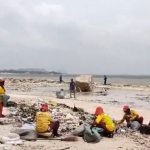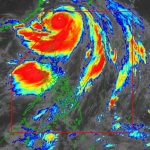
Still one of the most disastrous natural disasters striking numerous countries all around is flooding. Often driven by combining topographical, climatic, and infrastructure components, it causes significant damage, relocation, and death. Some countries have continuous issues because of their low-lying coastal areas, proximity to rivers, or frequency of heavy monsoons. Others battle the effects of insufficient infrastructure that accentuates flood impact, quick urbanization, and deforestation. From Bangladesh and India to Brazil and Nigeria, the constant fear of floods affects national economies and livelihoods impacting millions of people.
Here we look more comprehensively at some of the countries most likely to experience floods and look at the underlying reasons for their particular sensitivity to such natural disasters.
Bangladesh: an Underwater Nation
Bangladesh is among the most flood-prone countries in the world given its geographical position in the Ganges-Brahmaputra delta, where three main rivers converge. Rising sea levels, monsoons, and tropical cyclones all help to cause regular flooding this low-lying nation suffers. With very catastrophic floods impacting up to 75% of the geographical area of the country, 21% of it is underwater on average. One extreme illustration of this was the 1998 floods, which wrecked millions of houses and generally wreaked havoc.
Natural disasters have been exacerbated by climate change, which has produced more erratic and strong weather patterns, therefore making floods ever more unpredictable. Severe rain, upper river basin deforestation, and poor urban design have exacerbated the issue, hence turning frequent floods into prolonged and devastating disasters.
Bangladesh remains particularly vulnerable given a rising sea level and population even if continual attempts to lower flood hazards—such as building flood shelters and embankments—are under progress. Apart from uprooting people, floods in this region impair agricultural land, therefore jeopardizing livelihoods and food security.
India: Menace of Monsoons
India is not uncommon in struggling with catastrophic floods with its large river systems and annual monsoon season. The country suffers some of the greatest monsoon rains known worldwide with low-lying areas and river basins particularly prone to flooding. Well-known for bursting during the rainy season, the Ganges and Brahmaputra rivers generate major flooding affecting millions of people. Kerala’s state endured among the worst floods it has ever seen in 2018 as torrential rain caused major landslides and displaced about a million people.
Unchecked urbanization, deforestation, and poor drainage systems—particularly in large cities—help to worsen flood effects on India. In places including Assam, Bihar, and Uttar Pradesh, recurrent floods have become a seasonal occurrence that disturbs communities, ruins crops, and compromises infrastructure. Though the Indian government has made investments in early warning systems, dams, levees, and other flood control facilities, the frequency and strength of these storms pose ongoing challenges.
The Netherlands: A Masterful Story of Flood Control
Among the most flood-prone nations is the Netherlands, which has low-lying topography and much of its territory below sea level. Still, the Dutch have developed among the most advanced flood control systems available anywhere. Designed following the catastrophic North Sea Flood of 1953, which killed over 1,800 lives, the Delta Works, a large network of dams, sluices, locks, and levees, today this system protects the country against both river and coastal flooding in addition to continuous water management improvements.
Still, the Netherlands is vulnerable to the effects of climate change, particularly rising sea levels and greater precipitation—even with these incredible flood defenses. The government is also considering various strategies, including “living with water,” in which case regions of people may be safeguarded by purposely flooding during storms. Though the Netherlands leads the world in flood control, it always battles to combine its need for land reclamation with the realities of a continuously changing environment.
Guyana: Vibrant Coastal Nation Sensibly Affected
Given most of its population lives on low coastal plains, Guyana is particularly vulnerable to floods in South America. Their vulnerability is heightened as the coastal parts of the country are below sea level and only covered by a chain of crumbling sea walls. Especially in the rainy season, excessive rainfall regularly overwhelms drainage systems and results in floods forcing tens of thousands of people from their homes. The largest flood in Guyana’s recent history occurred in 2005; with over 300,000 people, or roughly 40% of the nation’s population, relocated and considerable economic damage done.
Poor infrastructure, climate change, and rising sea levels still pose a threat even if Guyana’s government is striving to improve flood defenses. Regular flooding affects Georgetown’s capital city; without significant water management infrastructure investment, future flood risks are expected to rise in step with increasing storm intensity and rainfall.
China: Extensive River Flooding
China boasts Yangtze and Yellow Rivers among the largest and most powerful river systems worldwide, well-known for seasonal flooding. Summer’s strong rains that overwhelm these rivers lead to major floods able to affect millions of people. China faced one of its worst floods in recent years in 2020 with torrential rains along the Yangtze River basin displacing millions and severely destroying infrastructure, crops, and houses.
Including the Three Gorges Dam, the largest hydroelectric dam in the world, the Chinese government has significantly sponsored flood control projects. Although these massive engineering projects have helped some floodwaters to be under control, their environmental impact and population dislocation have attracted criticism. Moreover, as climate change alters weather patterns, the government of China is still largely worried about the likelihood of more frequent and disastrous floods.
Keep Reading
Colombia: landslides and river overflow
Because of its varied topography, Colombia is vulnerable to several types of natural disasters like floods and landslides. Strong tropical rain falling on the country causes rivers to flood metropolises and rural areas alike. 2010 marked the most horrible storm in modern history when relentless rain caused major flooding and landslides, uprooting around 2.4 million people and badly hurting the economy.
Especially vulnerable to landslides in heavy rain, the mountainous parts of the country can obstruct rivers and increase flooding downstream. The Colombian government has made efforts to improve flood prediction and management, but the country’s flood risk remains high particularly in areas where unregulated development and deforestation have eroded natural flood barriers.
Indonesia: An Archipelago Forecast to Flood
An archipelago of more than 17,000 islands, Indonesia carries significant flood hazards with a tropical climate and sensitivity to increasing sea levels. Jakarta is particularly prone to flooding since much of the capital is sinking from groundwater extraction. Strong monsoon rains mixed with poor drainage systems can generate severe floods that displace hundreds of people from their homes annually. Tens of thousands of people were driven to escape and whole districts flooded; Jakarta experienced one of its worst floods in recent memory in 2020.
Apart from urban floods, storm surges and increasing sea levels, Indonesia’s coastal areas are threatened and therefore maybe millions of people would be displaced in the coming decades. Although the Indonesian government has launched several flood control projects, including erecting sea barriers and the dubious proposal to move the capital to the island of Borneo, regulating the nation’s complicated flood threats remains a difficult undertaking.
Pakistan: Indus, Monsoon Flooding
Particularly in the Indus River basin, which runs across Pakistan, monsoon-driven floods are rather likely to strike the country. Pakistan endured one of the worst floods in its history when massive monsoon rains drove the Indus River to overflow in 2010, devastating infrastructure, agriculture, and life as well as affecting about 20 million people. With one-fifth of the country submerged in floods, millions were displaced and long-lasting social and economic harm followed.
Although the Pakistani government has later made investments in flood early warning systems and upgraded river embankments, the country remains vulnerable to future monsoon floods especially given climate change is expected to raise the frequency and intensity of extreme weather events.
Brazil: Slides and Floods From Mountainsides
Brazil, a country well-known for its tropical rainforests and rugged topography, has significant flood risks particularly in regions probably prone to landslides and heavy rain. In the southern state of Rio Grande do Sul, severe floods claimed 181,000 lives and drove another 580,000 people to evacuate. Deforestation and poor urban planning worsen these floods, which could lead to landslides demolishing homes and infrastructure in mountainous regions.
Brazil’s flood risks should get worse in the future years since climate change increases the frequency and intensity of extreme weather occurrences. Rapid development, Amazon destruction, and inadequate infrastructure taken together have made the country progressively prone to floods and landslides.
Vietnam: Typhoon and river flood
Vietnam’s lengthy coast and near proximity to the South China Sea make it highly vulnerable to typhoons and river flooding. Low-lying coastal towns are extensively flooded by typhoon-induced regular extreme rain and storm surges. Typhoon Molave devastated buildings and infrastructure as well as caused severe flooding and landslides in central Vietnam, therefore uprooting thousands of people.
Especially the Red River and Mekong River, Vietnam’s river systems are prone to seasonal flooding that might destroy agricultural crops and disrupt commerce. Although the Vietnamese government has developed flood control measures, rising sea levels and climate change are expected to increase the flood risks of the country.
The Philippines
Among the most disaster-prone countries in the world, the Philippines lies along the Pacific typhoon belt and is regularly blasted by powerful storms. Typhoons generate tremendous floods in both urban and rural areas by spewing gobs of rain. Tens of thousands of people were uprooted and infrastructure was gravely damaged as Typhoon Noru tore through the country in 2022 causing horrific floods.
Along with typhoons, the Philippines suffers flooding from rising sea levels and storm surges. With millions of people at risk of being displaced from upcoming floods, the combination of geography, climate change, and poor urban design has made flood management a serious national challenge.
Nigeria: Niger River and Rapid Urbanization
Due in great part to the seasonal overflow of the Niger River, particularly during the rainy season, Nigeria, the most populated country in Africa, is prone to floods. Deforestation, poor urban design, and rapid population increase have all contributed to higher flood risks recently experienced. Extreme flooding projected in 2022 caused great damage to infrastructure, crops, homes, and over a million people were displaced.
In flood-prone regions, Nigeria’s urban centers—especially Lagos’ megacity—are also vulnerable due to poor drainage systems and uncontrolled construction. The Nigerian government is working to better manage floods, but future flood risks will most likely be raised by the nation’s growing population and the effects of climate change.
Germany: Rivers Still Under Risk
Germany is fairly prone to floods, especially from rivers like the Rhine and Elbe, even though often linked with cooler weather. Especially in the summer, regular river flooding results from heavy rain combined with rising water levels. Extreme floods devastating Germany’s southern and central districts in June and September 2024 inflict great damage on homes, businesses, and infrastructure.
By increasing storm frequency and severity as well as rainfall, climate change is expected to increase Germany’s flood risks. The country is still vulnerable to future floods especially in areas prone to river overflow even if the government has established thorough flood management plans with early warning systems and improved river embankments.
Mozambique: Cyclone-induced river floods
Mozambique on Africa’s southeast coast experiences significant flood risks due to its sensitivity to storms and heavy rains. As Cyclone Idai unleashed severe flooding all throughout the country in 2019, over 600 people and hundreds of more were killed and displaced. Particularly the Zambezi River, the river systems of the country are prone to seasonal flooding that can ruin agricultural crops and lead to population displacement.
Climate change is expected to produce more intense cyclones and raise sea levels, therefore increasing the flood risks in Mozambique. Though the government of the country is working to raise flood readiness, the extent of the issue is vast, particularly in rural areas with poor infrastructure.
Nepal: Mountains and monsoons
Nepal’s hilly topography and monsoonal temperature make landslides and flooding more likely. Monsoon season strong rain causes rivers to overflow, producing catastrophic floods in both rural and urban areas. Over 150 people died and hundreds of homes, farms, and roads were seriously damaged from extreme floods in 2017.
Especially prone to landslides, the mountainous parts of the country can cause river blockage and worsening of flooding downstream. Rising frequency and intensity of monsoon rains driven on by climate change is expected to increase Nepal’s flood risks even further.
South Sudan: Seasonal flooding in the wetlands known as Sudd
South Sudan, one of the newest countries on Earth, has significant flood risks from its seasonal rains and vast wetlands. Among the largest wetlands on Earth, the Sudd wetlands are particularly vulnerable to flooding during the rainy season, which causes yearly displacement of thousands of people. Record floods in 2021 caused approximately 700,000 people to flee their houses; entire towns were inundated and crops were ruined.
Political upheaval, poverty, and inadequate infrastructure all enhance the flood hazards of the country and impede the use of reasonable flood control measures. Climate change is expected to raise the frequency and intensity of rainfall in the area, thereby increasing the flood threats to the vulnerable South Sudanese population.
Finish: An Overseas Assignment
Flooding remains a global issue as countries all over face a range of flood hazards generated by topographical, climatic, and infrastructure factors. Many places are expected to be more susceptible to floods as sea levels rise and climate change keeps intensifying storms. While some countries—such as China and the Netherlands—have developed advanced flood management systems, others—particularly in the underdeveloped world—remain rather vulnerable to the catastrophic results of floods. Dealing with the global flood disaster in the next years will depend mostly on international cooperation, investment in flood barriers, and campaigns to slow down climate change.


























